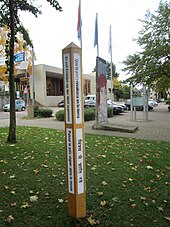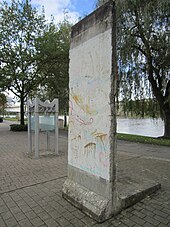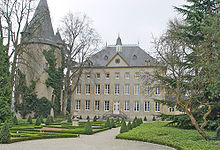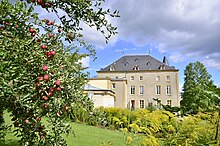Schengen
| coat of arms | map |
|---|---|
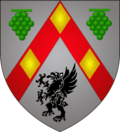
|

|
| Basic data | |
| State : |
|
| Coordinates : | 49 ° 28 ' N , 6 ° 22' E |
| Canton : | Remich |
| Residents : | 4833 (January 1, 2019) |
| Area : | 10.6 km² |
| Population density : | 454.7 inhabitants / km² |
| Municipality number: | 1206 |
| Website: | www.schengen.lu |
| politics | |
| Mayor: | Michel Gloden |
| Elective system : | Majority vote |
Schengen is a municipality in the Grand Duchy of Luxembourg and belongs to the canton of Remich .
geography
Geographical location
The municipality is located in the south-east of Luxembourg, right on the triangle formed by Germany ( Saarland ), France ( Lorraine ) and Luxembourg .
On the other side of the Moselle is the German municipality of Perl and south of it the French municipality of Apach .
composition
The municipality of Schengen consists of the following localities:
- Bech small makers
- Bürmeringen
- Elvingen
- Emeringen
- Remersian
- Schengen
- Floating singing
- Wave stone
- Wintringen
The town hall is located in Remerschen.
The village of Schengen is a small wine-growing village on the Moselle . It was the main town of the community consisting of the towns of Remerschen, Schengen and Wintringen, which was originally called Remerschen . On September 3, 2006, she was known on the basis of the international, signed in 1985 here agreement to Schengen renamed.
Memberships
The municipality is a member of the following municipal associations: Am Haff, SESE, SIAER, SICEC, SIGI, SIGRE and SYVICOL.
The partner municipality is Ischgl in Austria.
Schengen Agreement
Schengen became a synonym for an area without border controls when, on June 14, 1985, five EU member states signed the Schengen Agreement on the Moselle ship MS Marie-Astrid near this location , which called for the removal of controls at the common borders and the introduction of provides for the free movement of people and goods. On the banks of the river, the European Museum and a European monument commemorate the signing of the contract. The Schengen Agreement and other agreements to implement the project form the so-called "Schengen acquis". The Schengen Agreement came into force on March 26, 1995 and, like the introduction of the common currency, the euro, on January 1, 1999, is a milestone in the European process.
On February 8, 2010, a piece of the Berlin Wall was erected in front of the European Information Center Center Européen in Schengen . The European Museum was then inaugurated on June 13, 2010, to celebrate the 25th anniversary of the Schengen Agreement. On 200 square meters, the visitor learns everything there is to know about the history and significance of the Schengen Agreement. Historical photos, film and sound recordings as well as statements by those involved at the time on their motivation document the signing of the 1985 agreement, which is also on display.
The heart of the museum is an interactive map animation. Here you can find concise information on the history of the borders of the individual Schengen states and other EU states that have not yet joined the Schengen area . The aim of the animation is to explain to the visitor how the borders and the related political and economic power relations have shifted within the continent of Europe since 1815. The difference between the Schengen area and the EU is also made clear.
Worth seeing
In addition to the monument to the Schengen Agreement, Schengen offers other sights. Landmarks of the place are the church and a castle, as well as the remains of a moated castle from the 13th century. The reconstructed baroque garden of the palace is part of the gardens without borders . The castle, most recently the holiday and children's home of the monastic women's order of the St. Catherine sisters , was leased by them and converted into a hotel, which opened in spring 2010 and closed again in summer 2014.
From Schengen, the “Luxembourg Wine Route” leads along the Moselle in a north-easterly direction to the mouth of the Sauer near Wasserbillig . On the German side, this wine-growing region is called the " Southern Wine Moselle ", which forms part of the Mosel-Saar-Ruwer wine-growing region .
According to historians' judgment, a watercolor made by Goethe shows a tree of freedom erected in Sierck against the background of the Schengen Stromberg.
More Attractions:
See also
Individual evidence
- ↑ STATEC Luxembourg - Population par canton et commune 1821–2019 (French)
- ↑ Annuaire des Communes: Schengen ( Memento of the original dated December 8, 2015 in the Internet Archive ) Info: The archive link was inserted automatically and has not yet been checked. Please check the original and archive link according to the instructions and then remove this notice. (PDF; 30 kB), Syvicol
- ↑ Part of the Berlin Wall in Schengen. ( Memento of the original from February 11, 2010 in the Internet Archive ) Info: The archive link was inserted automatically and has not yet been checked. Please check the original and archive link according to the instructions and then remove this notice. Luxemburger Wort, updated February 8, 2010.
- ↑ Hotel in the castle. The Goeres group of companies helps the triangle to become a "Hôtel de Charme". ( Memento of the original from December 13, 2009 in the Internet Archive ) Info: The archive link was automatically inserted and not yet checked. Please check the original and archive link according to the instructions and then remove this notice. Luxemburger Wort , updated December 7, 2009. most recently according to KStA of June 16, 2010
- ↑ Lord of the castle wanted: “Château de Schengen” is being sold Luxemburger Wort , April 24, 2014, accessed January 6, 2015
- ^ Gunther Franz: Goethe in Trier. P. 17 ff. In: Goethe in Trier and Luxemburg. 200 years of the campaign in France 1792. Catalog of the exhibition of the Trier City Library, the Luxembourg National Library and the Weimar Classic Foundation. 1992. ISSN 0942-7031 , ISBN 2-87980-005-6 . / Gunther Franz, Jean-Claude Muller: Goethe's first encounter with the revolution. The freedom tree near Sierck. In: Hémecht , 44, 1992, pp. 5-17.
